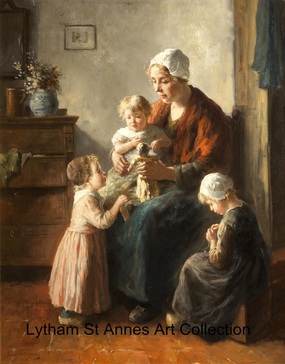Mother and Children
|
Research by Marjorie Gregson
|
|
ARTIST
Bernard de Hoog was born in 1867 in Amsterdam, Holland. He showed talent as a schoolboy but his request to study art was refused and he spent two or three years working in an office. However, his drawings in a work’s ledger were seen by a merchant who commissioned him to paint a portrait of his wife. With the merchant’s encouragement he went to a drawing master and then a drawing academy. A subsidy from the Dutch queen made his last years as a student easier. De Hoog was a student at the Quellinus school in Amsterdam, studying under J F Hulk and J C van Hessen. He worked for some time under one of the greatest Dutch animal painters, Jan van Essen, and copied many of the old masters such as Pieter de Hooch and Frans Hals. His painting from nature enabled him to understand the old masters. In addition he admired the paintings of Jozef Israels and Albert Neuhuys. During 1886 his talent became noticed and the first great picture he exhibited, During the Sermon in the New Church, was shown in Amsterdam. Later he was known to have held exhibitions in Arnhem, Amsterdam and Rotterdam. De Hoog became a painter of interiors as he lived in a village rich in them. He continued with this work for four years until he moved with his family to another province. His talent and originality were now fully appreciated. Looking back at the late eighteenth and early nineteenth centuries he followed The Hague School, primarily a movement of realism. The artists turned away from academic themes and mythology and painted realistic scenes of their immediate surroundings, including rural landscapes, peasant life, beach scenes and occasionally urban streets. In the tradition of the great Dutch artists they were sensitive to the effects of light and atmosphere. De Hoog was especially noted for his scenes where children played a major part. He painted the homes of peasants with the light shining through the windows and scenes of the life of country people. His paintings were readily exported to the United States, Canada and England. He died in The Hague in 1943 and occupies a distinguished place among the masters of the modernist movement in Holland. PAINTING This painting was completed in 1925 and is typical of many works by de Hoog, a genre painter who specialised in the subject of mother and child or children. In this we see the interior of the cottage and the effect of light and shade playing on the tranquil family group. The triangular composition of the figures draws the eyes to the mother’s fond expression but the faces of the children are also carefully portrayed. De Hoog transforms the ordinary domestic scene into something of beauty and one that would appeal to the buying public of the day. DONOR The painting was donated by Richard Shore, who was born in Ramsbottom, Bury in 1858. In 1881 he was living in Ramsbottom and working as a bookkeeper in a chemical works. By 1901 he was living with his wife, Elizabeth Ann, in Ramsbottom and was described as a manufacturing chemist and employer. He was still living there in 1911 and had two servants. There is no mention of any children. In 1924 he was living in Riley Avenue, St Annes and by 1934 had moved to Queen’s Road. In 1937 it was reported in The Lancashire Daily Post that Mr and Mrs Shore of St Annes had endowed an 'Annie Shore cot' to Ramsbottom Hospital. This was a cottage hospital supported by local benefactors, fund raising and voluntary contributions. It opened in 1899 and closed in 2008. Mrs Shore died that year, aged 81, and Mr Shore died in 1946, aged 88, the year of the donation. |
REFERENCES
Wikipedia advanced www.findmypast.co.uk www.bbc.co.uk/yourpaintings www.odonwagnergallery.com www.amounderness.co.uk |


